Catàleg Raonat: Commented works, Santiago Pastor
A big work, this, that approximates us, with renowned fidelity, to what has been the artistic work of Antoni Miró. Texts of deep route determine an accurate analysis, and of quality contrasted, Antoni Miró, artist of desire and witness of the real world of Fernando Castro, The reality of a rebel of Fernando Castro, Taxonomies of the production of Antoni Miró of Santiago Pastor. Also, we can track, through the singularity of the images that assist us, at the contemplation of the works that have been living matter and hope of the artist along the years of effort and of constant work. [CATALOGUE RAISONNÉ, Painting, Drawing, Collage 1960-2020: Volume I | Volume II]
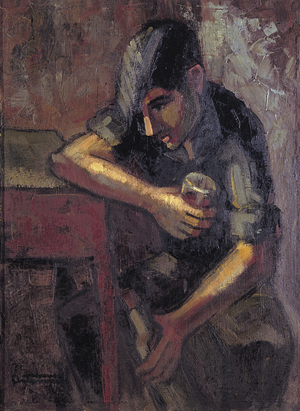 EL BEVEDOR, 1960 (Oli/llenç, 82x60)
EL BEVEDOR, 1960 (Oli/llenç, 82x60)There is good reason for considering this piece as the first true work by Antoni Miró. The painting can be taken as marking the beginning of the artist’s career not merely because it initiated a series of works, [...]
Full text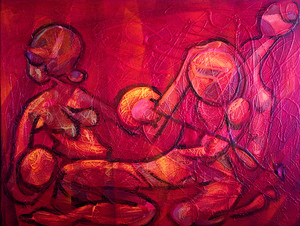 COMPOSICIÓ DE CARN, 1967 (Esmudina i sintètic / taula, 110 × 170)
COMPOSICIÓ DE CARN, 1967 (Esmudina i sintètic / taula, 110 × 170)During the experimental phase that is included within the latter part of the “Opera Prima” series, Antoni Miró created several works that explored different artistic languages and pictorial techniques. This painting is a clear example of this. [...]
Full text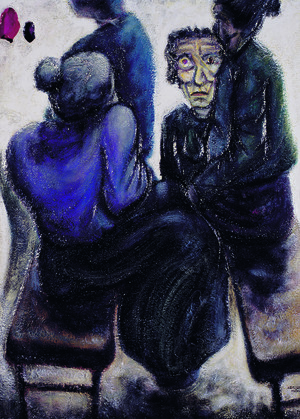 VELLES BOGES AL MANICOMI, 1967 (Sintètic / poliestirè, 135 × 100)
VELLES BOGES AL MANICOMI, 1967 (Sintètic / poliestirè, 135 × 100)Giving visibility to suffering has been a recurrent concern throughout Antoni Miró’s career, and it has also been present from the very beginning, from the stage associated with the series we call “Opera Prima”. [...]
Full text VIETNAM-1, 1968 (Sintètic / cartó, 97 × 66,5)
VIETNAM-1, 1968 (Sintètic / cartó, 97 × 66,5)The worldwide furore over the ravages of the Vietnam War is manifest in this work by Antoni Miró. [...]
Full text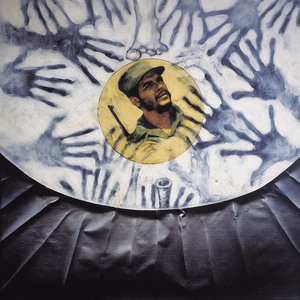 A CHE GUEVARA, 1970 (Acrílic / llenç, 90 × 90)
A CHE GUEVARA, 1970 (Acrílic / llenç, 90 × 90)The Bolivian Army — aided by the CIA — killed Che Guevara three years before Antoni Miró painted this picture. The United States managed to eliminate who was trying to spark revolution throughout Latin America. [...]
Full text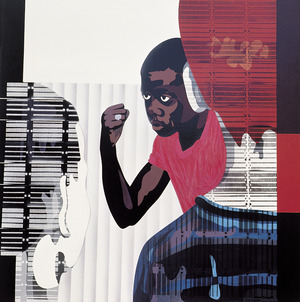 LLUITA D’INFANTS, 1972 (Acrílic / taula, 100 × 100)
LLUITA D’INFANTS, 1972 (Acrílic / taula, 100 × 100)The “Black America” series forms part of the defence made by Antoni Miró of the underclass. This work denounces the marginalisation found in American suburbs, juvenile delinquency, and the battle against racism. [...]
Full text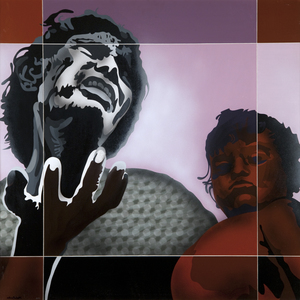 GEST DE FAM, 1972 (Acrílic / taula, 100 × 100)
GEST DE FAM, 1972 (Acrílic / taula, 100 × 100)The bipolar Cold War world relegated underdeveloped countries to a third place, in which poverty was the norm and hunger devoured entire populations. [...]
Full text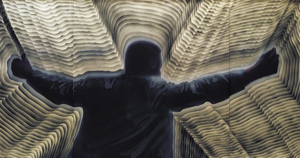 IGUALTAT PER A TOTHOM, 1972 (Acrílic / taula, tríptic 100 × 200)
IGUALTAT PER A TOTHOM, 1972 (Acrílic / taula, tríptic 100 × 200)The artist’s commitment shows a more optimistic side in this work. Demands for racial equality — such as those made by Martin Luther King — are a big influence on Antoni Miró. [...]
Full text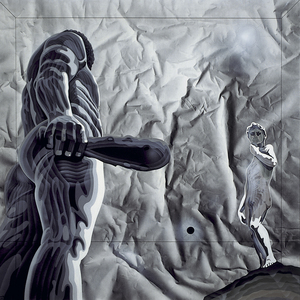 HERCULUSA I DAVIET, 1973 (Acrílic / llenç, 150 × 150)
HERCULUSA I DAVIET, 1973 (Acrílic / llenç, 150 × 150)In this work, Antoni Miró introduces the representation of two visions of the statues marking the entrance to the Old Palace in Florence: a replica of David by Michelangelo, and Hercules and Cacus by Bandinelli. [...]
Full text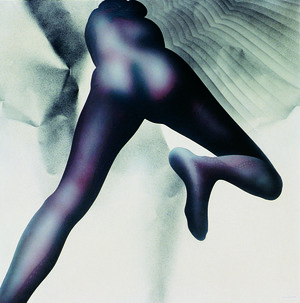 LA FUGIDA, 1973 (Acrílic / llenç, 100 × 100)
LA FUGIDA, 1973 (Acrílic / llenç, 100 × 100)Sensuality and hope go hand-inhand in this painting. The artist offers a glimpse of desire that expresses a wish to make this world a better place. [...]
Full text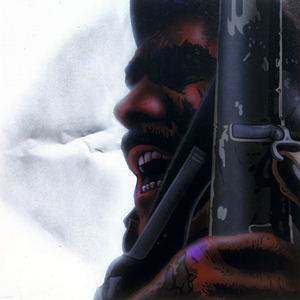 GUERRER ÀRAB, 1973 Acrílic / llenç, 100 × 100)
GUERRER ÀRAB, 1973 Acrílic / llenç, 100 × 100)Throughout his career, the artist has kept a constant, critical gaze on the injustices threatening the world. At the beginning of “The Dollar” and “Today’s Man” series, this is made clear regarding situations arising in various far-off places. [...]
Full text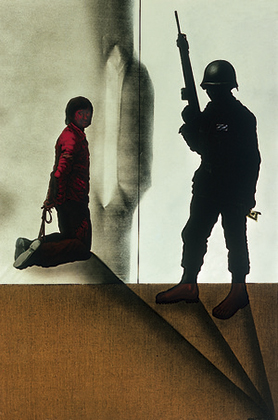 LA GRAN MASSACRE SUBVENCIONADA, 1974 (Acrílic / llenç 150 × 100)
LA GRAN MASSACRE SUBVENCIONADA, 1974 (Acrílic / llenç 150 × 100)The “Chile” sub-series forms part of “The Dollar” series. Shortly after the 1973 military coup d’état overthrowing Chile’s government under President Allende, the artist began denouncing the involution that the take-over supposed for both Chile and Latin America as a whole. [...]
Full text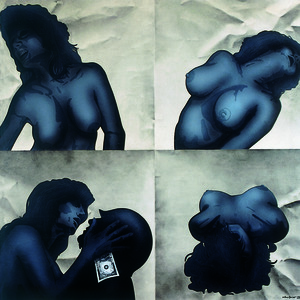 UNA NOIA I UN SOLDAT, 1974 (Acrílic / llenç, 100 × 100)
UNA NOIA I UN SOLDAT, 1974 (Acrílic / llenç, 100 × 100)This work falls into two thematic areas typifying the development of Antoni Miró’s pictorial discourse: political-social denunciation and eroticism. It belongs to “The Dollar” series, through which the author scathingly criticises Capitalism and US Imperialism in the first half of the seventies, which coincided with the Oil Crisis and the last stages of the Vietnam war. [...]
Full text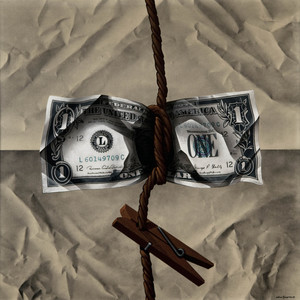 DÒLAR ENFORCAT, 1974 (Acrílic / llenç, 100 × 100)
DÒLAR ENFORCAT, 1974 (Acrílic / llenç, 100 × 100)The “El Dòlar” series occupies a key place in Miró’s artistic career. In it, the artist broadens the scope of his denouncement of racist repression in the US (formulated in “Amèrica Negra”) and encompasses America’s expansionist policies, which are channelled through the globalisation of neoliberalism. [...]
Full text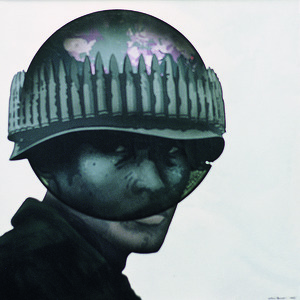 A VIETNAM LA RAÓ HA GUANYAT, 1975 (Acrílic / llenç, 70 × 70)
A VIETNAM LA RAÓ HA GUANYAT, 1975 (Acrílic / llenç, 70 × 70)This work is part of “The Dollar” series and echoes some of the work covering the Vietnam War at the end of the previous decade. [...]
Full text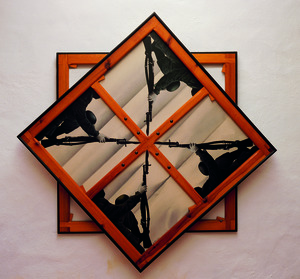 SOBRE LA PROCESSÓ, 1975-76 (Pintura objecte, (2) 100 × 100)
SOBRE LA PROCESSÓ, 1975-76 (Pintura objecte, (2) 100 × 100)Antoni Miró’s series “El Dòlar” is directed against Yankee imperialism. With his criticism, the artist denounces American warmongering and the neoliberal polices it tries to foist on other nations as the world’s leading economic power. [...]
Full text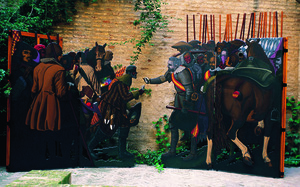 LLANCES IMPERIALS, 1976-77 (Pintura objecte, 250 × 850)
LLANCES IMPERIALS, 1976-77 (Pintura objecte, 250 × 850)While still busy with “The Dollar” series, Antoni Miró made, in the beginning of the Spanish Transition, this work as a vindication of a nationalist and anti-domination nature. All of the artist’s reflections in the late 1960s and most of the 1970s focused on the world’s ills under Yankee Imperialism. Now his attention shifts to problems closer to home and that have a strong bearing on his ideological stance, namely his defence of Catalan culture and national identity. [...]
Full text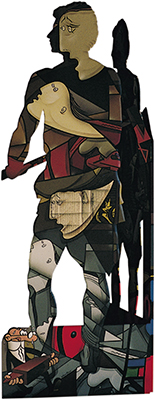 ENCLUSA I MALLAIRE, 1981-88 (Pintura objecte, 190 × 150 (2))
ENCLUSA I MALLAIRE, 1981-88 (Pintura objecte, 190 × 150 (2))In the ‘Paint Painting’ series, fragments of some masterpieces of art history canon are incorporated in the artist’s compositions. They are formally transformed and their meanings changed. Miró uses irony to build a new meaning that draws on the communicative power of canonic works. [...]
Full text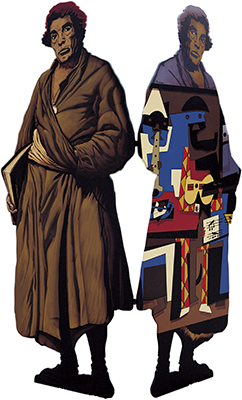 ISOP BUSCA MÚSICS, 1981-91 (Pintura objecte, 183 × 153 (2))
ISOP BUSCA MÚSICS, 1981-91 (Pintura objecte, 183 × 153 (2))In Miró’s ‘Paint Painting’ series, it is common of the artist to superimpose various fragments of works that, though all make up the canon of art history, are drawn from very different periods and styles. [...]
Full text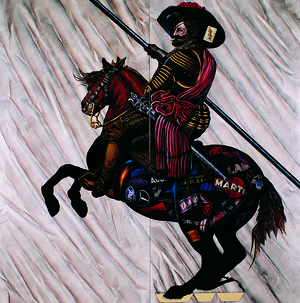 RETRAT EQÜESTRE, 1982-84 (Acrílic / llenç, 200 × 200 (Díptic))
RETRAT EQÜESTRE, 1982-84 (Acrílic / llenç, 200 × 200 (Díptic))This is one of the most singularly representative works in the ‘Paint Painting’ series, which was executed during the nineteen-eighties. Through it, Antoni Miró made political criticisms by pictorially transforming masterpieces from the art history canon, combining these icons with uses and pieces from the visual culture of the moment. [...]
Full text DIÀLEG A TRES, 1987 (Pintura objecte, 98 × 136)
DIÀLEG A TRES, 1987 (Pintura objecte, 98 × 136)In the ‘Paint Painting’ series, Antoni Miró expresses his criticisms and complaints using a repertoire that is shared and known by everyone, coming as it does from the art history canon. These “quotations and references” often allow his works “to stalk us” through “irony, metonymic play, covert metaphor, and the shock produced from the most straightforward comparison”, as Roman de la Calle puts it. [...]
Full text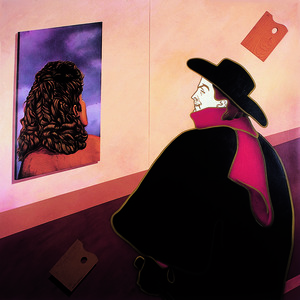 ARISTIDE ESGUARDANT GALA, 1988 (Acrílic / taula, 200 × 200 (Díptic))
ARISTIDE ESGUARDANT GALA, 1988 (Acrílic / taula, 200 × 200 (Díptic))The “Paint Painting” series can be seen as a meta-pictorial exercise that turns the discipline of action into the focus of attention. This approach creates meaning through the incorporation of diverse, de-contextualised fragments of the history of the genre to new compositions. [...]
Full text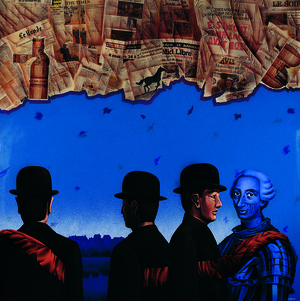 EL MISTERI REPUBLICÀ, 1988 (Acrílic / taula, 200 × 200 (Díptic))
EL MISTERI REPUBLICÀ, 1988 (Acrílic / taula, 200 × 200 (Díptic))This picture is part of the ‘Paint Painting’ series and draws on two other iconic works in the history of art. The main source of inspiration is the work by the Belgian surrealist Magritte, titled Le Chef-d’Oeuvre ou Les mystères de l’horizon [The Masterpiece or The Mysteries of the Horizon] (1955). [...]
Full text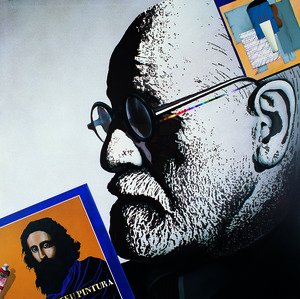 PSICOANÀLISI DE LA PINTURA, 1988 (Acrílic / llenç, 200 × 200)
PSICOANÀLISI DE LA PINTURA, 1988 (Acrílic / llenç, 200 × 200)This work explains one of the keys to the “Pinteu Pintura” (Paint Painting) series, of which it is a part. Romà de la Calle referred to the strange obsession that characterised this stage of Antoni Miró’s work. [...]
Full text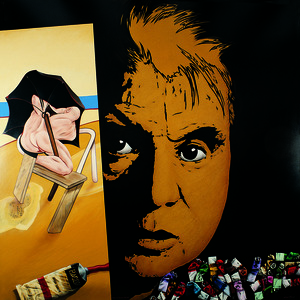 MÓN DE BACON, 1988-89 (Acrílic / llenç, 200 × 200)
MÓN DE BACON, 1988-89 (Acrílic / llenç, 200 × 200)In the “Pinteu Pintura” (Paint Painting) series, Antoni Miró took iconic works from Art History to come up with his own formulations, whether of a critical-political nature or as homage to an ‘Old Master’. [...]
Full text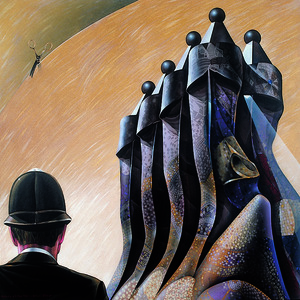 VIGILANTS A L’ALBA, 1989 (Acrílic / llenç, 100 × 100)
VIGILANTS A L’ALBA, 1989 (Acrílic / llenç, 100 × 100)This painting is part of the “Pinteu Pintura” (Paint Painting) series. It is a singular canvas within this series, since its features clearly depart from those of most of the other works. [...]
Full text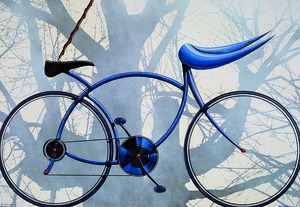 BICI-BOU-BLAU, 1991 (Acrílic / taula, 68 × 98)
BICI-BOU-BLAU, 1991 (Acrílic / taula, 68 × 98)One of the artist’s main reasons for painting the “Vivace” series is to reflect on the relationship between Man and Nature. The background is clearly critical of the harm we inflict on the environment and is combined with an approach that has a certain optimism. [...]
Full text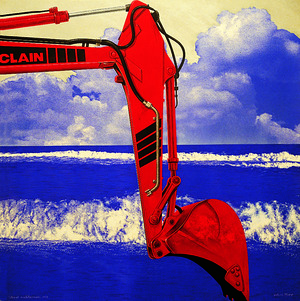 LITORAL MEDITERRANI, 1993 (Acrílic / taula, 98 × 98)
LITORAL MEDITERRANI, 1993 (Acrílic / taula, 98 × 98)As is typical of the “Vivace” series, environmental concerns are manifested in a seemingly non-conflicting way yet nevertheless express heartbreaking criticism. [...]
Full text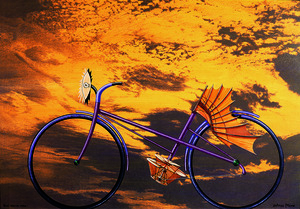 BICI AÈRIA, 1996 (Acrílic / taula, 68 × 98)
BICI AÈRIA, 1996 (Acrílic / taula, 68 × 98)This is one of the works in the “Vivace” series that shows most similarities with the foregoing “Paint Painting” series. The work reveals “a problem of an eco-social nature” which, as Blasco Carrascosa states, “stems from Man’s lack of awareness of his relationship with the environment”. [...]
Full text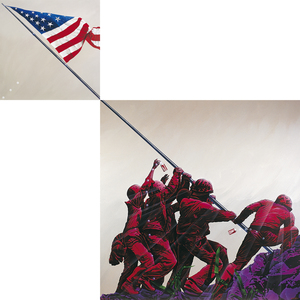 INTERLUDI, 1998 / Iwo Jima (Acrílic / llenç, 300 × 300)
INTERLUDI, 1998 / Iwo Jima (Acrílic / llenç, 300 × 300)The inspiration for Miró’s work is Rosenthal’s well-known photograph — Raising the flag on Iwo Jima (1945). The photo is one of the 20th Century’s most iconic pieces of picture-journalism and earned Rosenthal the Pulitzer Prize in the same year. [...]
Full text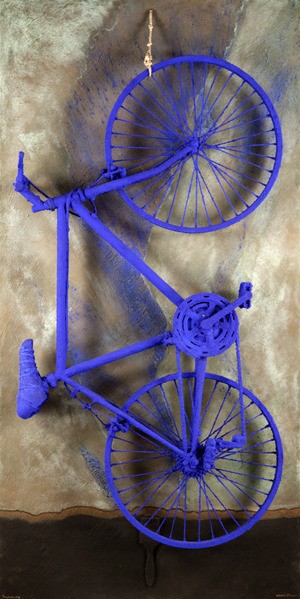 PENJADA, 1998 (Pintura objecte, 200 × 100 × 29)
PENJADA, 1998 (Pintura objecte, 200 × 100 × 29)This work is developed in dichotomous terms and comes at the end of the “Vivace” series. It is not a purely pictorial work. [...]
Full text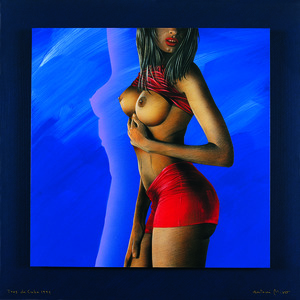 TROS DE CUBA, 1999 (Acrílic / taula, 45 × 45)
TROS DE CUBA, 1999 (Acrílic / taula, 45 × 45)Eroticism plays a very important role in Antoni Miró’s artistic career and this work is a case in point. It forms part of the “Some Nudes” sub-set of the “Vivace” series that was undertaken as the twentieth century drew to a close. As Blasco Carrascosa pointed out, “there is a natural and playful understanding of pleasure”. [...]
Full text EL MELIC, 2000 / L’Havana (Acrílic / llenç, 200 × 100)
EL MELIC, 2000 / L’Havana (Acrílic / llenç, 200 × 100)Antoni Miró ends the “Vivace” series with a sub-series titled “Some Nudes”, in which he returns to the representation of the female figure. These nudes are set against a deep blue background. [...]
Full text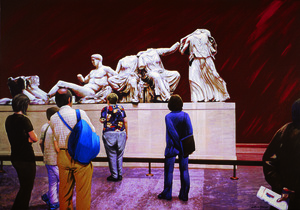 GRÈCIA AL BRITISH, 2002 / Londres (Acrílic i metall / llenç 81 × 116)
GRÈCIA AL BRITISH, 2002 / Londres (Acrílic i metall / llenç 81 × 116)During the first decade of the 21st century, the artist reflects on the role museums play in contemporary societies. This interest is embodied in a series of pieces that treat the museums scattered round the world in diverse ways. On some occasions, the museums are depicted as architectural artefacts that stand out in the urban setting as containers of art dominating the scenery. [...]
Full text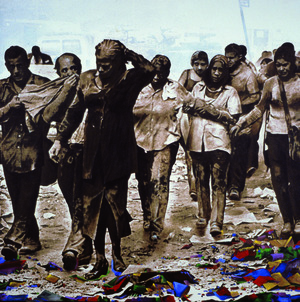 MANHATTAN PEOPLE, 2002 / Nova York (Acrílic / llenç, 116 × 116)
MANHATTAN PEOPLE, 2002 / Nova York (Acrílic / llenç, 116 × 116)One year after the turmoil caused by the attacks of 9-11, Miró reworked one of the most widely-used photo shoots in the media. [...]
Full text GUGGENHEIM MUSEOA, 2003 / Bilbao (Acrílic / llenç, 92 × 65)
GUGGENHEIM MUSEOA, 2003 / Bilbao (Acrílic / llenç, 92 × 65)This is one of the works included in the series about museums. On several occasions (and this is one of them) Miró is caught between appreciating a museum’s monumental qualities and denouncing the huge sums lavished on their construction. [...]
Full text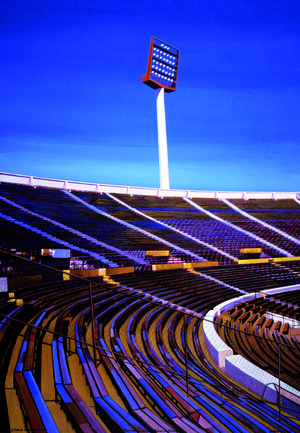 L’ESTADI NACIONAL. “HOMENATGE A LES VÍCTIMES DE PINOCHET”, 2004 / Xile (Acrílic / llenç, 116 × 81)
L’ESTADI NACIONAL. “HOMENATGE A LES VÍCTIMES DE PINOCHET”, 2004 / Xile (Acrílic / llenç, 116 × 81)One might say that the “Chile” sub-series, painted thirty years before this work, is the origin of the picture. Although Antoni Miró’s has always been a “political artist”, his works in the early 21st Century, though still denunciatory, are more reflective than the ones painted three decades earlier. [...]
Full text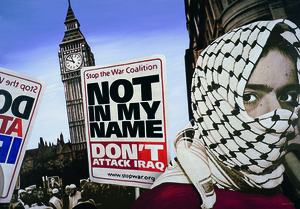 NO A LA GUERRA, 2004 / Londres (Acrílic / llenç, 81 × 116)
NO A LA GUERRA, 2004 / Londres (Acrílic / llenç, 81 × 116)Stop the War Coalition is a British peace organisation that has been fighting the so-called ‘war on terror’ campaigns waged since 2001 by the US (with the support of several allies, including the UK and Spain). [...]
Full text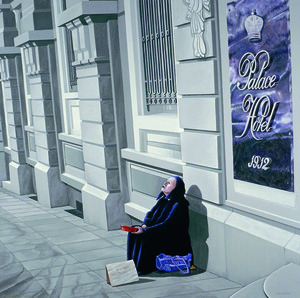 PIDOLAIRE AL PALACE, 2004 / Madrid (Acrílic / llenç, 116 × 116)
PIDOLAIRE AL PALACE, 2004 / Madrid (Acrílic / llenç, 116 × 116)The year 2004 will be remembered for the shocking terrorist attacks in Madrid. This work though touches on other kinds of horror. It was an election year in which the party in power changed. [...]
Full text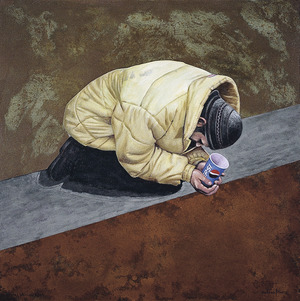 FER EL PLORICÓ, 2005 / Varsòvia (Acrílic i metall / llenç, 65 × 65)
FER EL PLORICÓ, 2005 / Varsòvia (Acrílic i metall / llenç, 65 × 65)Fernando Castro has written on Antoni Miró’s work that “the critical-artistic task involves facing conflicts honestly, even if is through unsettling pictures”. This is one of those images which produce a cold uneasiness when viewed. [...]
Full text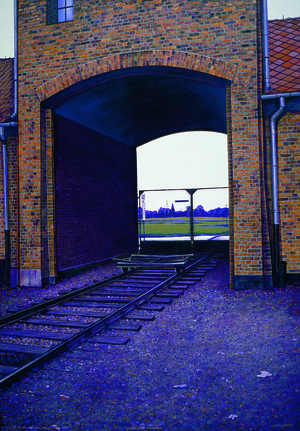 CIUTAT SENSE SORTIDA, 2005 / Auschwitz-Birkenau (Polònia) (Acrílic s/ llenç, 116x81)
CIUTAT SENSE SORTIDA, 2005 / Auschwitz-Birkenau (Polònia) (Acrílic s/ llenç, 116x81)Antoni Miró crafted this piece in 2005 — 60 years after the Red Army liberated the Auschwitz II-Birkenau concentration camp in Poland. Over 1,500 survivors of the camp attended the commemorative events that year. [...]
Full text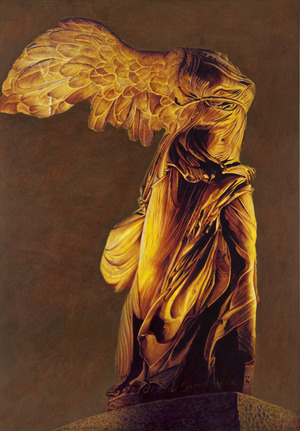 VICTÒRIA DE SAMOTRÀCIA, 2007 / París (Acrílic i metall / llenç, 162 × 114)
VICTÒRIA DE SAMOTRÀCIA, 2007 / París (Acrílic i metall / llenç, 162 × 114)Several canonical works feature in a part of the artist’s series on museums. Classical Greek works are among them. Those sculptures are brought by the painter as icons of the time during which the foundations of Western culture were set. [...]
Full text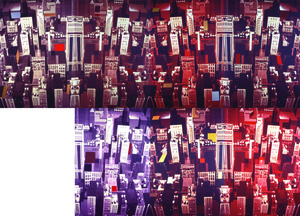 GRAN CIUTAT-DIPÒSIT, 2007 / Nova York (Acrílic / llenç, políptic, 7 de 162 × 114)
GRAN CIUTAT-DIPÒSIT, 2007 / Nova York (Acrílic / llenç, políptic, 7 de 162 × 114)As Ricard Huerta writes, Antoni Miró “feels like an urbanite in his condition of artist”. Miró clearly recognises the city as a political space, and much of his output in the first two decades of the 21st century covers the city [...]
Full text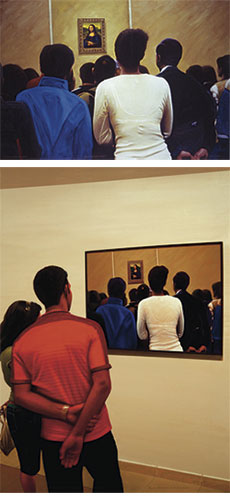 LA FAMOSA GIOCONDA, 2008 / París (Acrílic / llenç, 81 × 116) LA GIOCONDA A L'HAVANA 2009 / Cuba (Acrílic s/ llenç, 92x65)
LA FAMOSA GIOCONDA, 2008 / París (Acrílic / llenç, 81 × 116) LA GIOCONDA A L'HAVANA 2009 / Cuba (Acrílic s/ llenç, 92x65)These two works clearly deserve to be considered together. Both spark interest in meta-painting and use identical conceptual strategies, and furthermore, are based on the same canonical work: the portrait of La Gioconda [The Mona Lisa]. [...]
Full text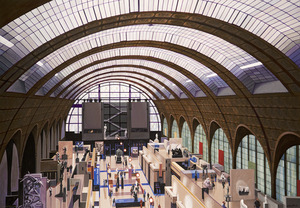 L’ESTACIÓ D’ORSAY, 2008 / París (Acrílic / llenç, 114 × 162)
L’ESTACIÓ D’ORSAY, 2008 / París (Acrílic / llenç, 114 × 162)In Antoni Miró’s series on museums, the artist reflects on whether these institutions continue to fulfil through their founding mission as repositories of cultural materials from the past, articulating these within a given narrative. Yet he also questions the protagonism of a museum building, which in principle is no more than a container for cultural contents. [...]
Full text AL VOLTANT DEL MUSEU, 2008 / L’Havana (Acrílic / llenç, 162 × 114)
AL VOLTANT DEL MUSEU, 2008 / L’Havana (Acrílic / llenç, 162 × 114)This work in Miró’s series on the contradictions surrounding art museums today raises the issue of the conflict between old and modern, and of the rift between society and the artistic objects held in such institutions. [...]
Full text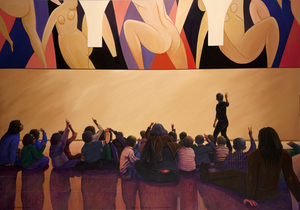 LA DANSA DE MATISSE, 2008 / París (Acrílic / llenç 114 × 162)
LA DANSA DE MATISSE, 2008 / París (Acrílic / llenç 114 × 162)As a part of his reflective exercises regarding museums, this work depicts an act of aesthetic reception in this indoor scene. It is a painting that eschews the critical approach found in the rest of the series, giving a clearly hopeful vision. [...]
Full text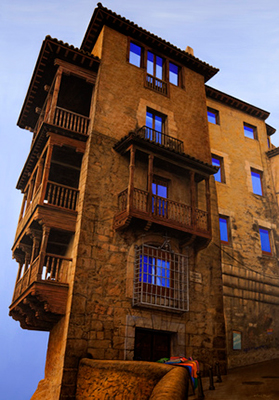 MUSEO CASAS COLGADAS, 2009 / Conca (Acrílic / llenç, 162 × 114)
MUSEO CASAS COLGADAS, 2009 / Conca (Acrílic / llenç, 162 × 114)This work is part of the artist’s series on museums. It touches on the tensions arising from the way culture is currently seen and the means used to disseminate it to society at large. It bears on the controversy between the container and the contents, with a commentary on the trivialisation and commercialisation of art. [...]
Full text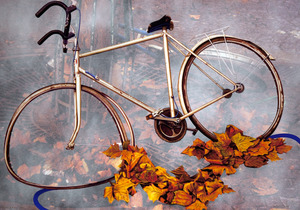 TARDOR A PARÍS, 2009 / París (Acrílic / llenç, 81 × 116)
TARDOR A PARÍS, 2009 / París (Acrílic / llenç, 81 × 116)As a metaphorical foundation, Miró uses bicycles, those ‘heavenly’ vehicles — as José María Iglesias put it —, to illustrate diverse ideas. The commonest — frequently found in the “Vivace” series — involves highlighting the lightness of bicycles (in both material and formal terms), and the sustainability of their use, as a means to referring to a kind of environmental paradigm. [...]
Full text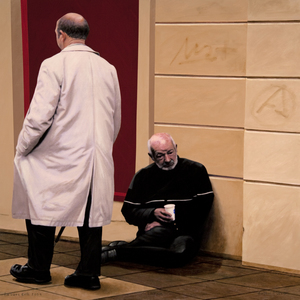 LA NOVA ERA, 2009 / Lublin (Acrílic / llenç 65 × 65)
LA NOVA ERA, 2009 / Lublin (Acrílic / llenç 65 × 65)On a street in the Polish city of Lublin, a beggar looks blankly for help as a person passes him by. The scene is very similar to others painted by the artist over these years [...]
Full text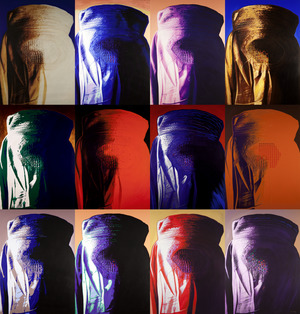 BURKA POLÍPTIC, 2010 / Afganistan (Acrílic / llenç, 486 × 456 – políptic (mesures variables))
BURKA POLÍPTIC, 2010 / Afganistan (Acrílic / llenç, 486 × 456 – políptic (mesures variables))Antoni Miró’s artistic output forms part of the “Sense Títol” (Untitled) series throughout the first decade of the 21st Century. The artist covers several themes, all of them of a very diverse nature. They include: poverty; immigration; war; memory; museums. Nevertheless, they all share their constitution as generic images. [...]
Full text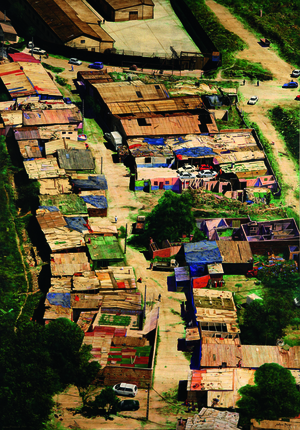 GRAN MADRID, 2010 / Barranquillas (Acrílic / llenç, 162 × 114)
GRAN MADRID, 2010 / Barranquillas (Acrílic / llenç, 162 × 114)Some of Miró’s works in his “Sense Títol” (Untitled) series tackle some aspects of social conflict. In them he refers to scenarios in which several social tensions take place. [...]
Full text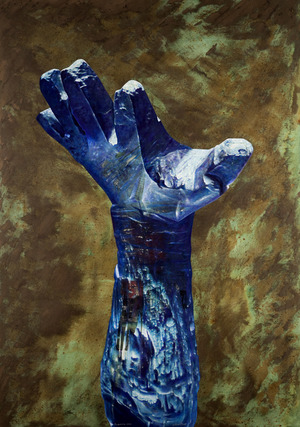 ESQUERRA, 2010 / Barcelona (Acrílic i metall / llenç, 162 × 114)
ESQUERRA, 2010 / Barcelona (Acrílic i metall / llenç, 162 × 114)Throughout his career, Antoni Miró has resorted again and again to pictorial representation (employing greater or lesser alteration and de-contextualisation) of certain fragments of paintings in the Western Canon of Classical and Modern Art. [...]
Full text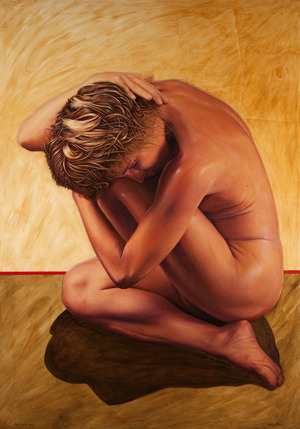 SOL SOLA, 2010 (Acrílic / llenç, 162 × 114)
SOL SOLA, 2010 (Acrílic / llenç, 162 × 114)Portraying an artist in action is something Antoni Miró has done on multiple occasions. Gades, Montllor or, as in this case, Picó, among others, have been the subject of his pictorial creations. [...]
Full text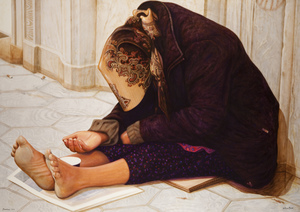 MENDICAR, 2010 / Barcelona (Acrílic / llenç, 114 × 162)
MENDICAR, 2010 / Barcelona (Acrílic / llenç, 114 × 162)Isabel-Clara Simó, speaking about how Antoni Miró looks at reality when beginning his works, highlighted three kinds of transformation. The second of these is the artist’s quest to ‘rescue’ reality from “everyday life, which renders objects and people opaque”. [...]
Full text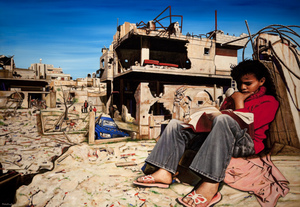 PALESTINETA, 2011 / Gaza Nord (Acrílic / llenç, 81 × 116)
PALESTINETA, 2011 / Gaza Nord (Acrílic / llenç, 81 × 116)The seemingly endless Palestinian-Israeli conflict makes it seem timeless. Several generations have lived their lives against the background of this conflict. [...]
Full text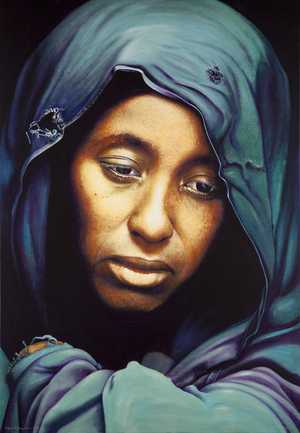 SAFIA A MUQDISHO, 2012 / Somàlia (Acrílic / llenç, 162 × 114)
SAFIA A MUQDISHO, 2012 / Somàlia (Acrílic / llenç, 162 × 114)Antoni Miró created this as part of the “Mani-Festa” series. The work portrays the pain of a mother cradling a dead baby in her arms. She grieves, sitting on the ruins and debris of Mogadishu Cathedral. [...]
Full text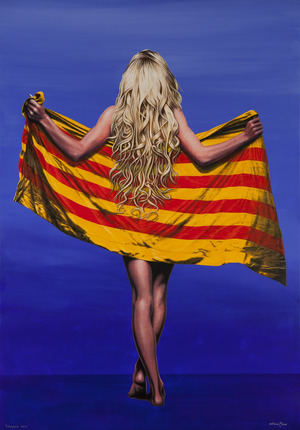 SENYERA, 2012 / València (Acrílic / llenç, 162 × 114)
SENYERA, 2012 / València (Acrílic / llenç, 162 × 114)The cover of the January 1998 issue of George magazine featured a photo of Pamela Anderson with an American flag covering her back. Later on, Antoni Miró used the picture to produce this work, which is a singularly relevant one in the “Mani-Festa” series.[...]
Full text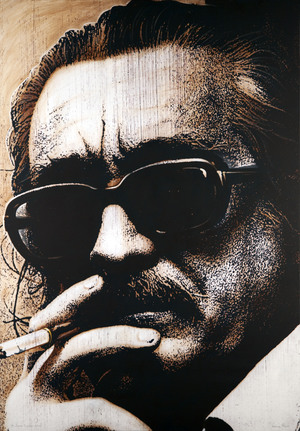 A JOAN FUSTER, 2012 / Sueca (Acrílic-mixta / llenç, 162 × 114)
A JOAN FUSTER, 2012 / Sueca (Acrílic-mixta / llenç, 162 × 114)One of the greatest intentions that animate the production of the series “Sense Títol” relates to the desire to pay homage to many important figures, especially those from the artist’s own culture. [...]
Full text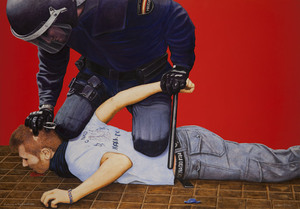 POLICIA A VALÈNCIA, 2013 (Acrílic / llenç, 81 × 116)
POLICIA A VALÈNCIA, 2013 (Acrílic / llenç, 81 × 116)The 20th of February of 2012 marked the fourth day of what was dubbed ‘The Valencian Spring’. Students protested on that day against cuts in public education by the national and regional governments — both then run by Partido Popular. [...]
Full text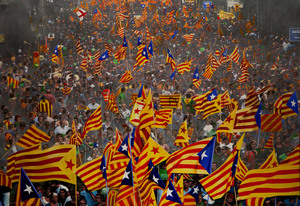 CATALUNYA DIU PROU, 2013 / Barcelona (Acrílic / llenç, 114 × 162)
CATALUNYA DIU PROU, 2013 / Barcelona (Acrílic / llenç, 114 × 162)This work is embodied in the “Mani-festa” series, through which the artist interpreted the tumultuous social events of the period. Romà de la Calle argues that the series of works “openly reflects the surrounding pulse of our complex lives during these critical, hard, and committed times”. [...]
Full text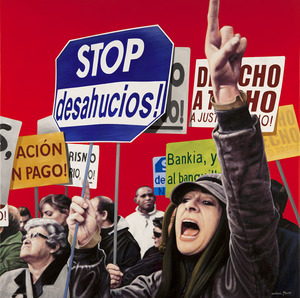 STOP DESNONAMENTS, 2013 / Madrid (Acrílic / llenç, 116 × 116)
STOP DESNONAMENTS, 2013 / Madrid (Acrílic / llenç, 116 × 116)There was a major wave of evictions in Spain in 2013. The dire consequences for the affected families sparked social outrage. As a result, there was a spate of demonstrations to demand debt cancellation and other measures. [...]
Full text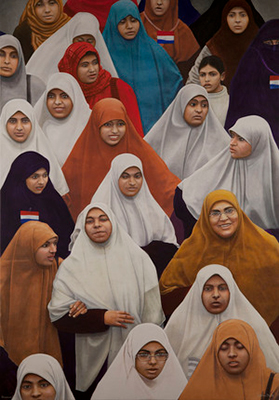 PRIMAVERA ÀRAB, 2013 / Alexandria, Egipte (Acrílic / llenç, 162 × 114)
PRIMAVERA ÀRAB, 2013 / Alexandria, Egipte (Acrílic / llenç, 162 × 114)This work is part of the “Mani-Festa” series. As Josep Sou explained so well, “the contemplation, identification and subsequent learning” of this artist’s work “leads to a social behaviour that needs to be completely reaffirmed”. [...]
Full text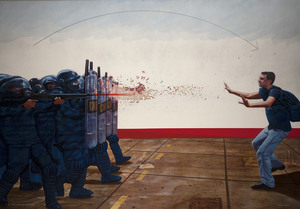 LA POLI A RIO JANEIRO, 2014 / Brasil (Acrílic / llenç, 114 × 162)
LA POLI A RIO JANEIRO, 2014 / Brasil (Acrílic / llenç, 114 × 162)Brazil’s troubled political situation in 2014, together with the country’s huge social inequalities, led to frequent mass demonstrations. [...]
Full text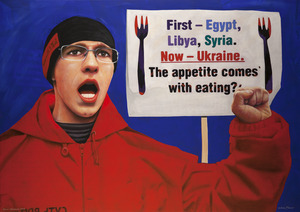 NOW UKRAINE, 2015 / Crimea (Acrílic / llenç, 114 × 162)
NOW UKRAINE, 2015 / Crimea (Acrílic / llenç, 114 × 162)The “Mani-Festa” series, to which this work belongs, comprises ‘decisive images’ that refer to “contemporary interpretations of reality”, as Romà de la Calle put it. [...]
Full text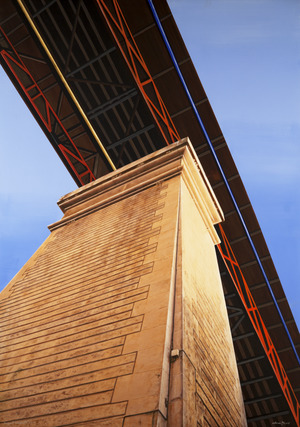 SUPORT VIADUCTE, 2015 / Alcoi (Acrílic / llenç, 162 × 114)
SUPORT VIADUCTE, 2015 / Alcoi (Acrílic / llenç, 162 × 114)In his “Slopes and Bridges” sub-series, Antoni Miró pays homage to his home town of Alcoi as the material expression of a hard-working society that is committed to culture. [...]
Full text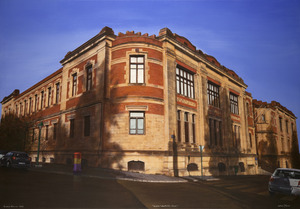 SUECO-NORUEC, 2015 / Alcoi (Acrílic / llenç, 116 × 162)
SUECO-NORUEC, 2015 / Alcoi (Acrílic / llenç, 116 × 162)Memory lets us gather threads of past events (especially those we have experienced directly) that we deem valuable and are in a way close for different reasons. [...]
Full text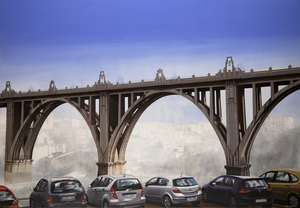 PONT I BOIRA, 2015 / Pont Sant Jordi, Alcoi (Acrílic / llenç, 114 × 162)
PONT I BOIRA, 2015 / Pont Sant Jordi, Alcoi (Acrílic / llenç, 114 × 162)The “Slopes and Bridges” series faithfully depicts various urban scenes in Alcoi, the town where Antoni Miró was born. All these vedute cover key buildings in Alcoi’s cityscape and collectively express the shared memory of the townsfolk. [...]
Full text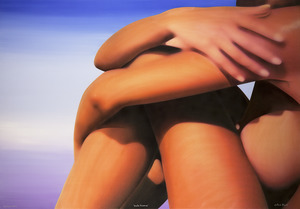 NILSA, 2015 / L’Havana (Acrílic / llenç, 114 × 162)
NILSA, 2015 / L’Havana (Acrílic / llenç, 114 × 162)This work is part of the “Havana Suite” sub-series. This musical term is used to denote giving the same tone to the whole — in this case, the eroticism of the female body, a theme running through the different paintings.[...]
Full text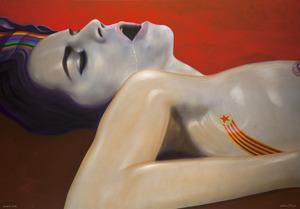 GELETA, 2015 / Altea (Acrílic / llenç, 114 × 162)
GELETA, 2015 / Altea (Acrílic / llenç, 114 × 162)Two common themes in the artist’s career — eroticism and his own culture — are combined in this picture. The merger is intended to strengthen the message of the picture. [...]
Full text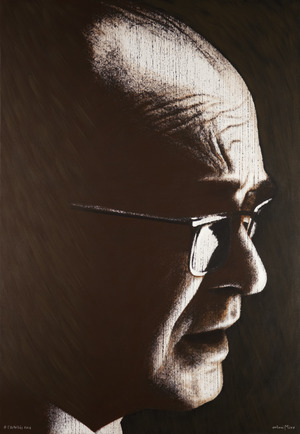 A L'ESTELLÉS 2016 / Burjasot (Acrílic-mixta / llenç, 162 × 114)
A L'ESTELLÉS 2016 / Burjasot (Acrílic-mixta / llenç, 162 × 114)This is a work that is both representative of the “Personatges” (Personalities) and the “Sense Sèrie” (Non-Series) series, and yet it also has features that set it apart. [...]
Full text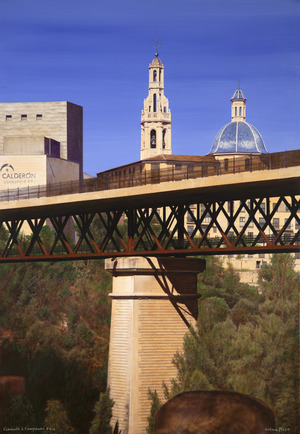 VIADUCTE I CAMPANAR, 2016 / Alcoi (Acrílic / llenç, 116 × 81)
VIADUCTE I CAMPANAR, 2016 / Alcoi (Acrílic / llenç, 116 × 81)This painting shows a current representation of a typical urban scene in Alcoi and forms part of the “Slopes and Bridges” series. It contains partial views of the elevation of the Canalejas viaduct and the bell tower and the dome of Santa Maria church. [...]
Full text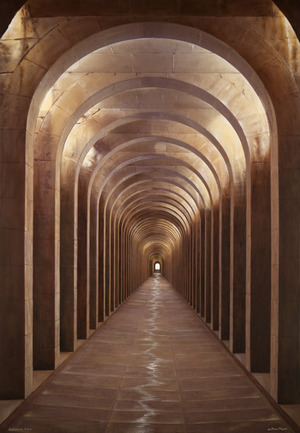 GALERIES, 2016 / Alcoi (Acrílic / llenç, 162 × 114)
GALERIES, 2016 / Alcoi (Acrílic / llenç, 162 × 114)This work is part of the “Slopes and Bridges” sub-series and depicts one of the galleries in the Sant Antoni Abat cemetery in Alcoi, whose origin dates back to the end of the nineteenth century — a time of fast population growth. [...]
Full text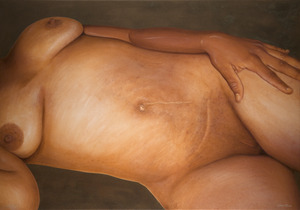 JULIET, 2017 (Acrílic i metall / llenç, 114 × 162)
JULIET, 2017 (Acrílic i metall / llenç, 114 × 162)This work is part of the “Suite Havana” sub-series, inspired by the beauty of Caribbean women’s bodies. The painting is imbued with a direct, warm eroticism. [...]
Full text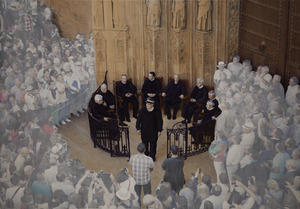 EXPECTACIÓ, 2017 / València (Acrílic / llenç, 65 × 92)
EXPECTACIÓ, 2017 / València (Acrílic / llenç, 65 × 92)This work is part of the “Tribunal de les Aigües” (The Water Tribunal) series, produced by Antoni Miró between 2016 and 2018. The artist focuses on this ageold Valencian customary court, which he honours for its civil and democratic traits and for having survived as a sign of identity until today. [...]
Full text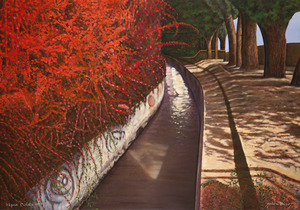 SÉQUIA DE MISLATA, 2017 / València (Acrílic / llenç, 65 × 92)
SÉQUIA DE MISLATA, 2017 / València (Acrílic / llenç, 65 × 92)Although this painting forms part of the same “Tribunal de les Aigües” (Water Tribunal) series as the previous work, its subject is quite different. [...]
Full text NU DEMPEUS, 2018 / PV (Acrílic / llenç, 195 × 130)
NU DEMPEUS, 2018 / PV (Acrílic / llenç, 195 × 130)In Miró’s recent “Nus i Nues” (Male and Female Nudes) series, the artist adds naked men to his erotic repertoire. To date, Miró had focused on female nudes.[...]
Full text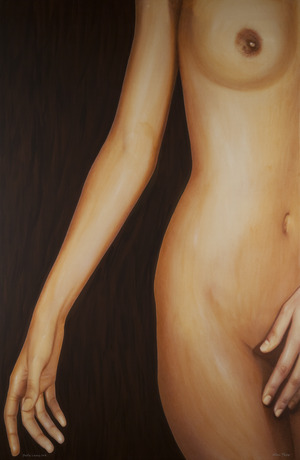 NUETA I MANS, 2018 / PV (Acrílic / llenç, 195 × 130)
NUETA I MANS, 2018 / PV (Acrílic / llenç, 195 × 130)Antoni Miró’s new series “Nus i Nues” (Male and Female Nudes) is a return to the artist’s erotic output. The looks, gestures, postures and other elements used in his previous erotic works have been tossed aside in this series. [...]
Full text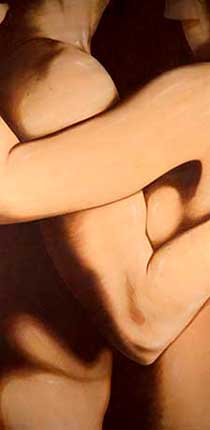 MIR I MERIGÓ, 2018 / PV (Acrílic / llenç, 200 × 100)
MIR I MERIGÓ, 2018 / PV (Acrílic / llenç, 200 × 100)Antoni Miró has tackled nudes extensively throughout his career. At times, the sensuality of the bodies has been the vehicle for transmitting a certain idea, alien to the nature of the medium. [...]
Full text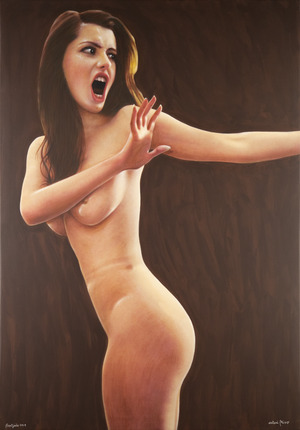 ASSETJADA, 2019 / PV (Acrílic s/ llenç, 162x114)
ASSETJADA, 2019 / PV (Acrílic s/ llenç, 162x114)In the subseries “Nus i Nues”, Antoni Miró confronts the naturalistic representation of human bodies, on a life-sized scale, or even larger, and with abundant definition. Focusing on showing nudity involves addressing, in direct terms and without obstacles or prejudices, an aspect of our presence that is usually forbidden to others.[...]
Full text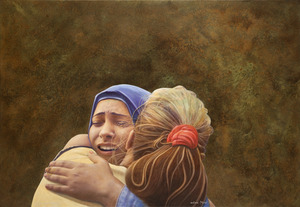 RESCAT DE MIGRANTS, 2019 / Mediterrani (Acrílic i metall s/ llenç, 81x116)
RESCAT DE MIGRANTS, 2019 / Mediterrani (Acrílic i metall s/ llenç, 81x116)It has been a constant throughout his career that the suffering of the underprivileged haunts the painter. For this reason, Antoni Miró has explicitly referred in many of his works to the ills they suffer. [...]
Full text